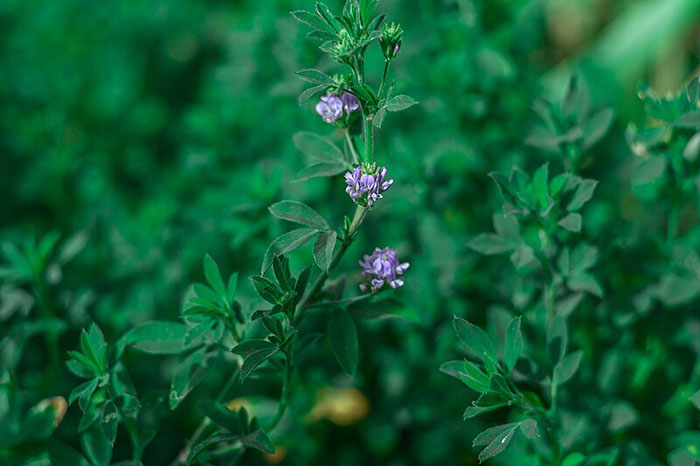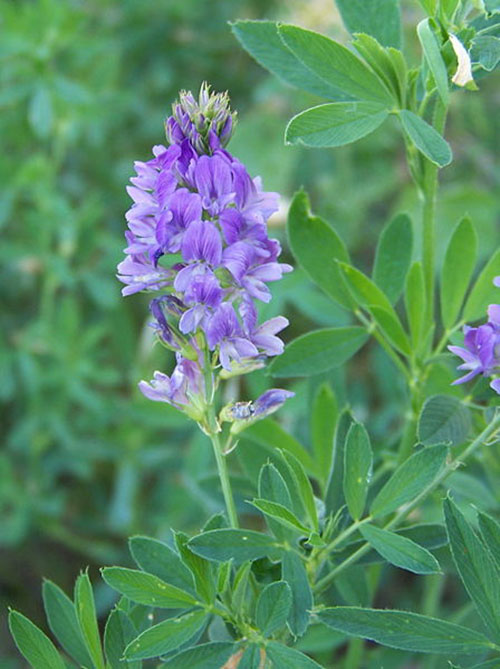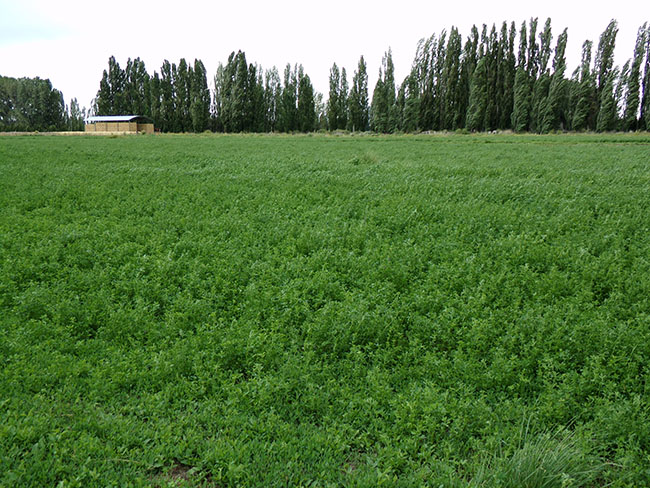Bulletin #2245, Maine Forage Facts: Alfalfa
Bulletin #2245, Maine Forage Facts: Alfalfa (PDF for printing)
By Jaime Garzon, Assistant Extension Professor and Forage Educator, University of Maine Cooperative Extension
For information about UMaine Extension programs and resources, visit extension.umaine.edu.
Find more of our publications and books at extension.umaine.edu/publications/.
Alfalfa
Alfalfa (Medicago sativa L.) is a deep-rooted perennial legume that grows in bunches or clumps. Leaves are trifoliolate. The outer one-third of each leaflet is usually (but not always) serrated or rough. They are narrow and oval, with a smooth upper surface and a slightly hairy lower surface. Alfalfa produces flowers on racemes (flower stalks), and each raceme possesses 10-35 densely packed flowers, from white, yellow, or purple color. Alfalfa produces spirally coiled seed pods, each containing 2 to 6 seeds. Pods may have smooth or hairy outer surfaces. Alfalfa plants can reach 15 feet tall and live for 3 to 8 years, depending on winter conditions. It is also known as lucerne.

Site selection
Alfalfa is adapted to a wide range of climates. As a result, it is one of the few crops grown in every state. Under favorable conditions, alfalfa roots may penetrate over 20 feet deep, so an established crop is very drought tolerant; growth slows or stops during drought but starts again when water is available. Alfalfa does not produce high yields or survive very long on either poorly drained or acid soils. It requires 6.5 to 7 soil pH. Below this level, acidity reduces the amount of N fixed by bacteria in the roots and shortens the life of the stand.
Soil preparation and establishment
Soil should be well prepared before planting alfalfa seeds. A firm seedbed is recommended to improve the stand by improving seed contact with the soil. That includes plowing/disking, harrowing, and rolling. This helps seeds retain moisture and prevents new roots from drying out. Alfalfa fields should be sown at ¼ to ½ inch deep in rows spaced 18 to 24 inches apart. Seeds should be watered immediately, and the bed should be kept moist while seedlings emerge.
There are about 200,000 alfalfa seeds per pound. When seeded alone, the seeding rate is 12 to 15 pounds per acre. When seeded in a mixture with other grass/crop, the amount of seed could be reduced to 8 to 10 pounds per acre. All planted seeds must be inoculated with Rhizobium meliloti bacteria to ensure biological nitrogen fixation capacity, and this inoculation is commonly included in certified seed.
Alfalfa plants produce toxins that can reduce the germination and growth of new alfalfa seedlings. This phenomenon is known as autotoxicity. The extent of the toxin’s influence increases with the age and density of the previous stand and the amount of residue incorporated before seeding. The autotoxic compounds are water soluble and are concentrated mainly in the leaves. The compounds impair the development of the seedling taproot by causing the root tips to swell and reducing the number of root hairs. This limits the ability of the seedling to take up water and nutrients and increases the plant’s susceptibility to other stress factors. A waiting period after removing the old stand is necessary to allow the toxic compounds to degrade or move out of the root zone of the new seedlings. Weather conditions influence the speed with which the toxins are removed. The breakdown is more rapid under warm, moist soil conditions. Growing a different crop for one season after plowing down the alfalfa or chemically killing a 2 year or older stand is recommended.
Carefully plan the planting operation (type of planter, weed control, seeding rates of alfalfa and grass, etc.) to get the alfalfa well established before the first winter. Spring seedings with or without small grain companion crops should be done before June 1. Summer seedings without small grains should be done before August 1 (northern Maine) or August 10 (central and southern Maine). Frost seeding is not recommended.
Alfalfa needs at least 6 weeks of growth after germination to survive the winter. The plant will generally survive if it develops a crown before a killing frost. The crown allows the plant to store root reserves for winter survival and spring regrowth.
Alfalfa can also be established with reduced tillage or no-till planting. However, careful weed control before planting is required. The same occurs with the application of fertilizers, lime, or manure.
Liming and fertilization
Phosphorous (P), potassium (K), and lime should be added according to soil test results to maintain productive, long-lived stands. Phosphorous is vital for alfalfa root development, while K affects alfalfa winter hardiness. Older stands need topdressing to maintain high yields. Topdress following the first cutting to stimulate second and third cutting regrowth or in early September to increase winter hardiness.
The lime reacts very slowly with soil acids, so it should be applied 6 months or earlier before seeding. The best time to apply for typical crop rotations is 1 year before alfalfa sowing.
Without a soil test, recommended fertilization could vary from 20 to 60 pounds of phosphate (P2O5) and 20 to 90 pounds potash (K2O) per acre for the establishment to 10 to 50 pounds P2O5 and 20 to 160 pounds K2O per acre for topdressing.
Varieties
The market currently offers a wide number of alfalfa varieties in Maine. The selection will depend on the specific characteristics that adapt better to the conditions of the farm. Alfalfa diseases are not a big problem in Maine, so varieties are usually selected based on winter hardiness, persistence, pest resistance, and yield potential.

Winter survival rating (or winter hardiness) is the ability of an alfalfa plant to survive the winter without injury. Winter hardiness for alfalfa varieties range from 1 to 6, with 1 being the most winter hardy and 6 the least hardy. The rating indicates longevity and potential to withstand multiple winters. For long term stands, alfalfa varieties with lower winter hardiness should have primary consideration in northern climates.
Fall dormancy relates to how soon an alfalfa variety stops growing in the fall and how early it begins growing in the spring. It is rated on a scale of 1 to 11, with 1 having the least fall growth and 11 with the greatest fall growth. Varieties with low fall dormancy ratings have slower shoot elongation and regrowth after harvest and have shorter prostrate shoots in the fall. Varieties with high fall dormancy ratings have erect shoot growth in the fall and quicker shoot elongation after harvest. They tend to start growing earlier in the spring, green up faster following cutting during the season, and grow taller in the fall. Fall dormancy ratings are a very good indicator of yield potential. The advantage of growing varieties with a larger number on the fall dormancy rating scale is generally higher yields.
In the Maine market, it is common to find alfalfa varieties with 1.7 to 2 winter hardiness, and 4 to 5 fall dormancy.
KingFisher 435 HD: High digestibility alfalfa. Resistance against stem nematodes, fusarium wilt, phytophthora, and anthracnose. Fall dormancy: 4.6. Winter hardiness: 1.7.
KingFisher Stronghold: High digestible alfalfa with a sunken crown for great traffic tolerance. This variety has branched roots to keep the plant firmly during soil freezing and thawing. This root distribution also may reduce the alfalfa sensibility to wet soils. Fall dormancy: 4.3. Winter hardiness: 1.8.
FSG 415BR: Alfalfa with branch root that provides reduced sensitivity to wet soils and tolerance to traffic pressure. Fall dormancy: 4.0. Winter hardiness: 2.0.
FSG 421LH: Alfalfa resistant to potato leafhopper. This and similar varieties are better adapted to rotations with potato crops since they also work as a break crop for this pest. Fall dormancy: 4.0. Winter hardiness: 2.0.
FSG 527: Alfalfa with high biomass production. This variety is preferable for hay production. Fall dormancy: 5.0. Winter hardiness: 2.0.
Viking 374HD: Alfalfa with high digestibility and rapid regrowth. It can give up to 5 cuttings per year, but its winter hardiness is lower than other varieties. Fall dormancy: 4.0. Winter hardiness: 1.7.
Leafhopper resistance comes from fine hairs on alfalfa stems and leaves, resulting in significantly fewer hoppers in resistant plants than in conventional ones. However, that could also increase the time needed to dry the biomass for hay production. Resistant varieties will surpass other strains when leafhopper pressure is heavy. Spraying in the seeding year may still pay under heavy hopper pressure.
Productivity
Under ideal conditions, alfalfa can produce more than 10 tons hay per acre of high-quality forage. More often, yields range from 3 to 5 tons per acre, depending on soil fertility.
Alfalfa-grass mixtures for hay or silage are the most common use of alfalfa in Maine and throughout New England. There are several reasons for this:
- Grass and alfalfa yield together is usually greater than either planted alone.
- As the alfalfa stands thins out or dies, the grass can fill in the stand. This may mean fertilizing the grass with nitrogen, but at least a forage crop is still available for harvest.
- The alfalfa-grass mixture can be grazed with less potential for bloat incidence.
In Maine, the grasses best adapted for use with alfalfa in a mixture are timothy, orchardgrass or meadow fescue. Timothy or meadow fescue should be seeded at 6 to 8 pounds per acre, while the more aggressive orchardgrass should be seeded at less than 4 pounds per acre. It is important to consider the flowering times of the grasses when mixed with alfalfa, to reach a harvesting time where all species are beginning to bloom. It is recommended to select medium or early heading varieties for timothy (Conquest, Kootenai, or Barfleo) and medium heading for meadow fescue (Laura or Liherold).
It is recommended to leave a residue height of 3 to 4 inches after the clipping/harvest. Alfalfa can tolerate a lower stubble height, but this will usually impact the performance of other forages on the field. Furthermore, lower stubble height would increase dirt buildup in the hay.

Grazing management
Farmers can cut alfalfa at different maturity stages to feed livestock with different nutritional needs. For milking dairy cattle, alfalfa is often cut in the bud stage, before blooming, to ensure high digestibility and protein content. In contrast, alfalfa for beef cows is cut during bloom, when digestibility and protein are lower, but the yield is higher. Generally, the best balance between yield and quality can be obtained when the alfalfa is harvested around the 30% bud growth stage.
Alfalfa proportion in the pasture should not exceed 30% to avoid the incidence of bloat in the animals. A higher proportion would suggest nitrogen fertilization to increase grass growth or dedicating that area for conserved forage production.
Additional Resources
References
CFAITC. Alfalfa. (2004). California Foundation for Agriculture in the Classroom, University of California. Sacramento (CA), United States.
Fernandez A, Sheaffer C, Tautges N, Putman D, Hunter M. (2019). Alfalfa, Wildlife & the Environment.
Griffin TS. (2004). Forage facts: growing forage legumes in Maine (Report 2261). University of Maine Cooperative Extension. Orono (ME), United States. National Alfalfa and Forage Alliance. St. Paul (MN), United States.
King’s Agriseeds Inc. Seed catalog. kingsagriseeds.com/
PlantVillage. Alfalfa. Pennsylvania State University. University Park (PA), United States. plantvillage.psu.edu/topics/alfalfa/infos/
Seedway-Growmark Inc. Seed catalog. seedway.com/
Thomas-Murphy J, Amsili J, Bergstrom G, Cherney J, Hansen J, Helms M, Hunter M, Kettering Q, Lawrence J, van Es H, Smith E, Smith M, Stanyard M, Workman K. (2023). Cornell Guide for Integrated Field Crop Management. University of Cornell Cooperative Extension. Ithaca (NY), United States. pp 90.
Undersander D, Cosgrove D, Cullen E, Grau C. Rice ME, Renz M, Sheaffer C, Shewmaker G, Sulc M. (2011). Alfalfa Management Guide. American Society of Agronomy, Crop Science Society of America, Soil Science Society of America. Madison (WI), United States.
Information in this publication is provided purely for educational purposes. No responsibility is assumed for any problems associated with the use of products or services mentioned. No endorsement of products or companies is intended, nor is criticism of unnamed products or companies implied.
© 2024
Call 800.287.0274 (in Maine), or 207.581.3188, for information on publications and program offerings from University of Maine Cooperative Extension, or visit extension.umaine.edu.
In complying with the letter and spirit of applicable laws and pursuing its own goals of diversity, the University of Maine System does not discriminate on the grounds of race, color, religion, sex, sexual orientation, transgender status, gender, gender identity or expression, ethnicity, national origin, citizenship status, familial status, ancestry, age, disability physical or mental, genetic information, or veterans or military status in employment, education, and all other programs and activities. The University provides reasonable accommodations to qualified individuals with disabilities upon request. The following person has been designated to handle inquiries regarding non-discrimination policies: Director of Equal Opportunity and Title IX Services, 5713 Chadbourne Hall, Room 412, University of Maine, Orono, ME 04469-5713, 207.581.1226, TTY 711 (Maine Relay System).

